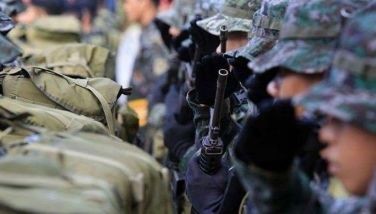Palace firm on public transport ban

MANILA, Philippines — Malacañang yesterday stood firm on its decision to continue banning certain modes of public transportation as a precautionary measure against the coronavirus despite a poll indicating that a majority of Filipino families view this as burdensome.
A mobile phone survey conducted by the Social Weather Stations (SWS) found 77 percent of respondents saying the suspension of public transport was a burden to their families.
The burden was greater for nearly half or 47 percent of families that do not own any vehicle, according to the non-commissioned nationwide poll conducted from May 4 to 10. Four in every 10 respondents or 40 percent said the suspension was “very burdensome” while 37 percent said it was “somewhat burdensome.”
Only 22 percent said they felt little or no burden from the suspension.
Presidential spokesman Harry Roque justified the transportation restriction, saying the government cannot be complacent until a vaccine for the pandemic is developed.
“We heard the sentiments and understand the predicament of workers (who commute) from their places of residence to their workplaces and vice-versa when we reopened the economy... We have to consider, however, that Metro Manila, is still under general community quarantine (GCQ); thus, the threat of COVID-19 (coronavirus disease 2019) still exists and is real,” Roque said in a statement.
“At this juncture, we still cannot let all modes of transportation to be on the streets. This will defeat the purpose of quarantine. Unless a vaccine or cure is available, we must not let our guards down,” he added.
Some forms of mass transportation are already allowed in GCQ areas but they cannot operate in full capacity to ensure safe physical distancing. Despite the relaxed quarantine measures, jeepneys are still not allowed because of difficulties in observing safe distancing.
Roque said the government is conducting daily assessments on the transport sector.
“The government is trying to do more in order to help everyone... What the administration is doing is balancing the need to revitalize the economy so that we can have livelihood and jobs while looking out for and protecting the health and safety of the public as well,” he said.
Roque also urged the private sector to provide shuttle services to their employees. He said the transportation department opened eight city bus routes last week and intends to open three more on Monday to address the problem of limited transportation.
The Department of Transportation (DOTr) is implementing a “partial, limited, calibrated, gradual” resumption of public transport under two phases.
From June 1 to 21, the available means of public transportation are trains, bus augmentation, taxis, transport network vehicle services (TNVS), shuttle services, point-to-point buses, public utility buses and bicycles. Public utility buses, which were supposed to resume operations during the second phase, were gradually allowed to ply roads during the first phase. The second phase, to be implemented from June 22 to 30, will allow modern public utility vehicles and UV express to resume operations.
Roque said 28 point-to-point routes with 268 bus units provided access to commuters from peripheral areas like Alabang, Bacoor, Bulacan and Antipolo.
Around 31,700 taxis and TNVs were also deployed, using cashless transactions and online payments for fare collection.
“In the case of health workers and medical frontliners, we have been continuously providing free rides in almost 20 routes and 95 hospitals around Metro Manila,” Roque said.
As of June 6, DOTr’s free ride for health workers has reached 1,073,975 persons nationwide.
- Latest
- Trending






























